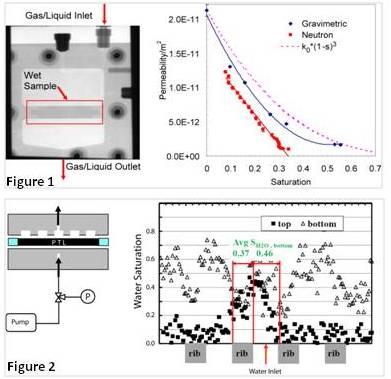Summary
Efficiently managing water transport in proton exchange membrane fuel cells (PEMFCs) is critical to the performance, cost, and durability in order for this technology to become the next automobile engine.
Description

Accurate, in situ characterization of the physical properties of a porous transport layer (PTL) – porosity distribution, liquid saturation as a function of pressure, liquid and gas permeability, thermal conductivity – is critical to improving the understanding, and hence manipulation, of the water transport in PEMFCs. In collaboration with the University of Kansas, neutron imaging has been used to perform measurements of the liquid and gas permeability and the liquid saturation as a function of pressure of PTLs. Shown in Figure 1 on the left is a neutron image of the device that was developed to measure both the liquid and gas permeability of PTL's.
On the right in figure 1 is a comparison of the in-plane permeability of air through the porous transport layer as a function of saturation as measured by neutron radiography and gravimetrically, as well as a common functional form for the permeability as a function of saturation. Since the gravimetric method requires disassembly, it is possible for the saturation in the porous transport layer to change during the measurement; this change can be directly observed by neutron radiography. An advantage of neutron imaging to traditional gravimetric methods is that the water mass measurement is performed in situ without disassembling the device. Also, the measurement can be made in a manner that is consistent with how the porous transport layer is used in an actual fuel cell; thus the liquid water content and distribution during the measurement is known and one can use the locally resolved data, for instance to understand the effects of non-uniform compression.
Such a measurement is shown in figure 2, which shows a device designed to mimic the compression experienced by a PTL in a real fuel cell with channels and ribs. The ribs compress the PTL, altering the pore size distribution and is seen to reduce the saturation at the top of the PTL after the applied pressure is sufficient for the liquid water to breakthrough to the top of the PTL. The ability to resolve the variation in saturation is critical to accurately model and control the water transport in hydrogen fuel cells.
Notice of Online Archive: This project ended in 2021 and thus this page is no longer being updated and remains online for informational and historical purposes only. The information is accurate as of 8 April 2021. For questions about page contents, please contact Dan Hussey.

